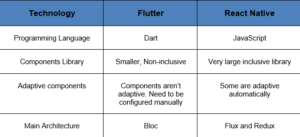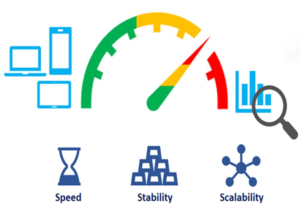Flutter vs. React Native

Let’s take a step back and examine the startling similarities between Flutter and React Native before digging into their differences. These are well-known and extensively used cross-platform development frameworks that let programmers use a single codebase to create apps for iOS and Android devices.
React Native and Flutter have communities that are alive and vibrant, in addition to providing unmatched efficiency and ease. These communities offer a wealth of knowledge, large libraries, adaptable widgets, and a variety of plugins to developers.
- Learning and Development Ease


Because React Native and Flutter are built on well-known programming languages, developers of all skill levels can readily use them. JavaScript, a popular language for online development, is used by React Native, but Flutter uses Google’s Dart object-oriented programming language.
Additionally, each framework has a built-in collection of developer tools to facilitate the development process. For example, Expo, a built-in debugging tool in React Native, lets developers test their code simultaneously across numerous devices. Similar to this, hot reloading is a feature of the Flutter development environment that enables real-time testing and modifications without the need to restart the application.
- Community Resources and Assistance
As already informed, the developer communities for React Native and Flutter are robust and helpful, providing a plethora of resources. Developers may readily get answers to their questions or contact other developers for advice through online forums, blogs, tutorials, and conferences devoted to these frameworks.

- Performance and Stability
Flutter uses a single codebase for both the iOS and Android platforms, which gives it an advantage when it comes to performance. This method minimizes the likelihood of platform-specific errors and inconsistencies while simultaneously speeding up development. Developers can construct a stable app with faster execution speeds with Flutter since it removes the requirement for distinct codebases.

React Native depends a lot on native components and APIs, which may affect performance if they are not appropriately tuned. Developers can, however, attain a performance level comparable to Flutter by utilizing third-party tools such as React Native Navigation and appropriate optimization strategies. Optimizing the code and utilizing extra tools allows React Native apps to provide an exceptional user experience and performance.
Head-to-Head Comparison: Flutter vs. React Native
Flutter and React Native have advantages and disadvantages of their own; it’s important to recognize some significant distinctions between the two that may influence your choice in 2024.
Programming language: Flutter makes use of Dart, a relatively recent and cutting-edge programming language with a special feature set for creating cross-platform apps. While not as popular as JavaScript, Dart offers a stable and effective framework for developing Flutter applications.

React Native, on the other hand, depends on JavaScript, a well-known language with a sizable and active community and a wealth of libraries and resources.
Hot Reload: Flutter’s ability to rapidly view the consequences of code modifications without restarting the application is one of its best features. Developers can iterate more quickly and effectively thanks to this rapid feedback loop, which also significantly accelerates the testing and debugging processes.
Although hot reloading for React Native is also possible, it is a little less fluid than Flutter and occasionally causes small bugs or app crashes.
UI elements: Flutter has a large library of modifiable widgets, giving developers access to a wealth of pre-built UI elements to construct aesthetically appealing and coherent user interfaces. More control and flexibility in UI design are possible with this native method. UI components for React Native, on the other hand, are sourced from third-party libraries, which provide a multitude of options but may result in differences in appearance and functionality between libraries.
Why develop mobile apps using React Native?
React Native allows developers to write code once and deploy it across multiple platforms, such as iOS and Android. This reduces development time and effort compared to building separate native apps for each platform.
Our proficiency with React Native development at Vibrant Info guarantees excellent cross-platform apps that endure throughout time. With a strong background in both upcoming technologies and mobile development, we provide solutions that are future-proof and customized to meet your needs. Our dedication to quality ensures a flawless user experience and top-notch performance on all platforms. Trust Vibrant Info to transform your vision into a cutting-edge mobile application that sets new standards in the industry.





